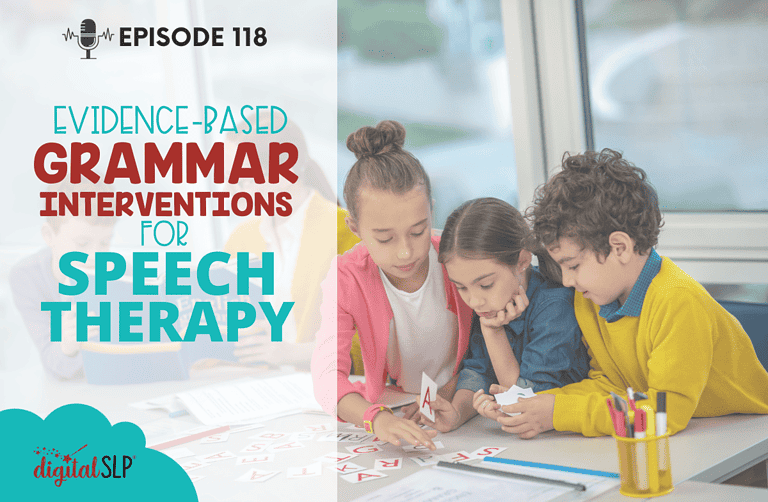In this episode, we talk all about interactive ways to target vocabulary development with students of all ages. From sensory bins to interactive books, and don’t forget scavenger hunts, we will be providing many ideas to start using within your therapy sessions!
Today I am going to be talking about 5 interactive ways for maximizing vocabulary development for students of all ages. In 2008, I recorded a podcast titled “Fun Ways to Work on Vocabulary” which will complement this podcast.
Interactive ways for maximizing vocabulary development:
1. Sensory Activities
Integrating sensory activities into learning new vocabulary allows students to hear the new vocabulary word, see the word, and touch the word. Furthermore, it allows students who participate in an activity to get a “feel” for that new word.
2. Interactive Books
Reading books with our students is one of the best ways to support learning new vocabulary because books often have pictures to go along with the context.
3. Games
Use fun and interactive games to target vocabulary development with your older students.
4. Picture Word Dictionary
Bring your students’ vocabulary words to life by using a picture-word dictionary page.
5. Scavenger Hunt
Have you tried incorporating vocabulary words within a scavenger hunt? It provides an interactive and exciting new way to target vocabulary development.
6. Vocabulary Toss
Vocabulary toss is a simple yet interactive game you can play with a speech therapy group when working with older students. Give your students a vocabulary word they are working on and toss the ball to one of the students to get the game going!
I hope this helps give you ideas for ways to maximize vocabulary development during speech therapy sessions. Moreover, they can be used for students of all ages, in in-person or teletherapy sessions. You will see how these interactive methods pique your students’ interest in learning new vocabulary.
Links & Resources
- The Digital SLP Membership
- The Digital SLP Podcast: Fun Ways to Work on Vocab
- Basic Vocabulary: Interactive book
- Prepositions: Interactive book
- Action Verbs: Interactive book
Are you seeking fun and interactive speech therapy materials that students and SLPs both will adore? Check out what the Digital SLP® membership site has to offer or sign up for our free trial now. If you are a fan of Teachers Pay Teachers, do check out my profile there.
Full Transcript of Podcast: Interactive Ways for Maximizing Vocabulary Development
Episode 74: Interactive Ways for Maximizing Vocabulary Development
You're listening to the Speech Space Podcast, a podcast full of tips and resources for SLPs. I'm your host, Jessica Cassity, and this is Episode 74.
Hey there everybody! Today, we are going to be talking all about interactive ways to target vocabulary development for students of all ages. So before we get started, I did want to mention that this podcast is brought to you by The Digital SLP membership site, which is a site that features time-saving interactive digital resources that are all teletherapy platform-friendly. So if you'd like to learn more about that, you can head on over to thedigitalslp.com/digitalslp. And we are offering a 7-day free trial right now, so you can take advantage of that as well. So back in May of 2018, I recorded a podcast that was called Fun Ways to Work on Vocabulary. And this podcast provided five general ways to work on vocab within your therapy sessions. So I will be linking that previous podcast in the show notes for you today so you can reference that if you're interested in learning a little bit more. Today, I'm going to provide you with some additional ways to work on vocabulary development, incorporating interactive lesson plans for students of all ages.
So let's go ahead and start off by talking about sensory activities. So integrating sensory activities into learning new vocabulary allows students to hear the new vocabulary word, see the word, touch the word, and even participate in an activity to get a feel for that new word. For example, when working with younger students and learning about gardening, you can approach this new topic with a sensory approach. So you can create a hands-on sensory experience where students are touching the soil, and putting on the gloves, and planting the seeds, and even watering the flowers or the plants. Now, if you can't get all of these materials, you can try creating more of a basic sensory bin with something like beans to represent the soil. And you can incorporate pictures of gardening vocabulary or objects that are in the bin, and you can even turn it into an I Spy game where you're searching through the beans to find pictures of the new vocabulary words. So there are definitely ways to improvise there. I personally am a fan of using hands-on sensory experiences using real-life items, like I mentioned initially with the soil and the seeds. But you know, that's not always going to be available and you might be working in a space that has, you know, space limitations, where you can't bring all those things in. So you can, like I said, you can definitely improvise but using sensory activities is a great way to work on vocabulary.
Now let's move on to interactive books. Reading books with our students is one of the best ways to support learning new vocabulary since books often have pictures that go along with the context. So you want to make sure that you read the books prior to showing your students in order to select vocabulary words that you plan to target in that session. So you want to go in already knowing what the book is about, already knowing the vocabulary words that you're going to be targeting. You're going to highlight these words as you read with your students in order to provide more exposure of this new word within the session. And you can also create adaptive interactive books to provide additional activities that continue to highlight the new vocabulary words. So, for example, you might want to printout pictures to go along with the book read with your students, put Velcro strips on a page, and then have your students follow along to the story, moving the pictures over to the Velcro strip. So your students are now about to hear the story while also visually seeing the pictures come to life in their own adaptive book as well. I have also included a link in the show notes for today for a few virtual interactive books that you can use in telehealth sessions when targeting vocabulary development. Now, I will say those do not go along with or complement a book. They are just basic vocabulary words but just to give an idea of a way that you could also do this virtually, I wanted to include that as well.
Another great way to target new vocabulary is through playing games. So for our older students, this can be especially engaging. So you can try incorporating games like Scrabble or even Bananagrams into your sessions. And instead of presenting your students with new vocabulary to learn in a traditional and almost, say boring setting, you can use games that will get your students to interact with new vocabulary words in an exciting way. You can even set rules where the students need to include certain vocabulary words on their Bananagrams board. So there are lots of different ways to get them excited, and engaged, and involved. Just like we do, with say, the sensory bins with our younger students.
Another fun one is a picture word dictionary. So you can bring your students' vocabulary words to life by using one of these picture word dictionary pages. And what you can do is dedicate one page to one vocabulary word, and you have the student write the word, draw picture of the word, write out the definition, and write the word in the sentence. You can even create a vocabulary binder for your students where they can place all these dictionary pages into their binder so they can refer back to them when needed. And it really allows the student to explore the new vocabulary word in their own way. And they generally do have fun drawing pictures to represent this as well as writing a sentence. Because you know, it's giving them a little bit more control and they're learning through different ways -- where they're hearing the word, they're seeing the word, they're writing the word or using it in context, and they're drawing as well. So that's another fun way to keep your students involved while learning new vocabulary words.
And another fun one is to do a scavenger hunt. So you can incorporate vocabulary words within a scavenger hunt to provide them with interactive and exciting new ways to target these vocabulary words. You can even adapt this activity to work for students of older and younger ages. So for younger students, you might want to use objects or pictures of objects to hide throughout the room. And then for older students, you're going to want to write out words, and provide the students with a definition, and then have them search for the written word that goes with that definition. And you can also place written definitions around the room and provide them with the vocabulary terms. So there's a few different ways that you can modify that to meet the needs of your students.
So the last step is to do a vocabulary toss. Now, this is a fun and interactive game that you can play with a speech therapy group when you're working with students that are a little bit older. You can provide your students with the vocabulary word that they're working on and toss a ball to one of the students. And then the student is going to define the word or say it in a sentence. And then the student provides a new vocabulary word and tosses the ball to a fellow student, and then you're going to encourage your students to help each other out, of course, if they have any trouble providing the definition or using the word in a sentence. So there can be a good bit of teamwork in that task as well. You know, keeping your activities fun and interactive, it's going to help to keep your students' attention while also providing them a multisensory experience when learning new vocabulary, which we know is super important for our students.
So that is it for me for today. Like I mentioned, at the beginning of the show, you can head on over to thedigitalslp.com/digitalslp to try out to the 7-day trial. And we will be back in a couple of weeks with another episode. Of course, do not forget to go to the show notes. If you want to reference the links mentioned in today's session, you can access those by going to bitly.com/TSSEP74. All right, everybody. I hope that you have a wonderful week and I will talk to you soon.













Recent Comments